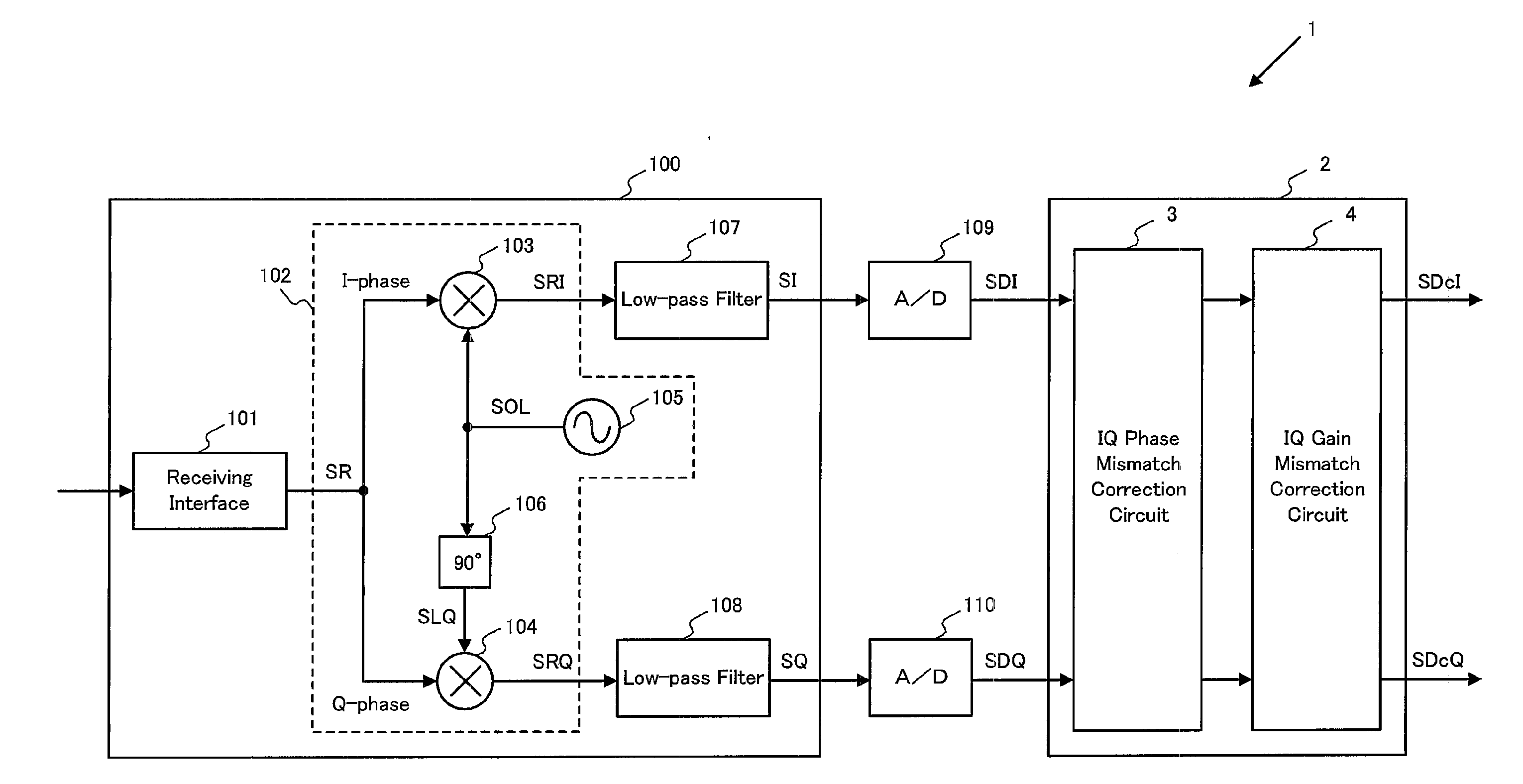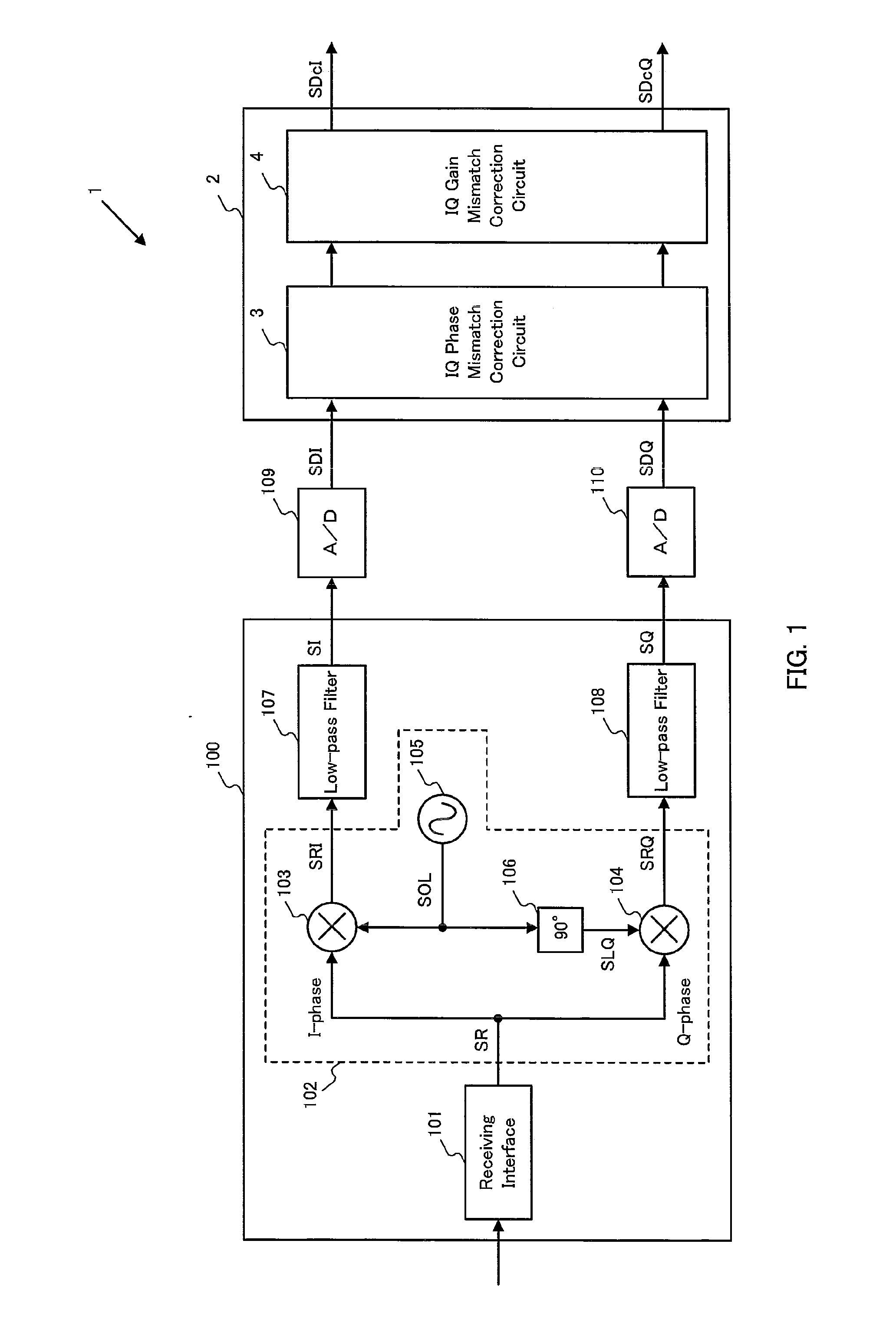[0021]Furthermore, in the IQ phase mismatch correction circuit and the IQ
gain mismatch correction circuit having the first characteristic features, since the first and second digital filters, the control circuits, and the analyzing filters process sequentially inputted signals in a
time domain, an IQ mismatch correction process can be continuously executed in actual time without interrupting reception of a digital baseband signal, i.e., without interrupting a receiving process or a demodulating process on a receiver side.
[0023]In the IQ phase mismatch correction circuit and the IQ
gain mismatch correction circuit having the second characteristic feature, since the number of control variables is not less than 3, a higher-order
adaptive filter can be realized, and a frequency dependent IQ mismatch correction process can be executed with high performance. However, as described above, since three or more control variables must be independently derived, diversity of each pair of
processing object signals inputted to the same number of control circuits as the number of control variables must be secured. When the number of analyzing filters is two or more, the diversity of the signals between all the pairs of
processing object signals can be reliably realized by differentiating
transfer function of one pair of analyzing filters from that of the other pair of analyzing filters, so that a frequency-dependent IQ mismatch correction process can be more accurately executed.
[0025]In the IQ phase mismatch correction circuit having the third characteristic feature, since
processing object signals inputted to the control circuits originally have orthogonality, by using multiplying process results (expressing IQ phase mismatch states at individual processing times) to each pair of processing object signals, a temporally averaged IQ phase mismatch state between the pair of processing object signals is measured to make it possible to sequentially execute the adapting processes of the control variables by the
least mean square algorithm. In the I-phase and Q-phase output signals, when the IQ phase mismatch is completely corrected, a temporal average of products of both the output signals is 0. On the other hand, in the IQ
gain mismatch correction circuit having the third characteristic feature, since the processing object signals inputted to the control circuits are originally normalized, an averaged IQ gain mismatch state between each pair of processing object signals is measured by using a multiplying process result to a subtracting process result and a addition result to each pair of processing object signals (expressing IQ gain mismatch states at individual processing times) to sequentially execute adapting processes for the control variables by the
least mean square algorithm. In the I-phase and Q-phase output signals, when the IQ gain mismatch is completely corrected, a temporal average of a product (difference between squares, i.e., an
electric power difference) between a difference and a sum of both the output signals is zero. Furthermore, an
algorithm except for a least
mean square (LMS)
algorithm (for example, recursive least square (RLS)
algorithm, a PID (Proportional Integral Derivative) algorithm, a maximum likelihood (ML) algorithm, and the like) can be used as an adapting algorithm of the control variables. However, the
least mean square algorithm has the
advantage of being considerably tougher and stabler than the other algorithms and being able to be realized by a small-scale circuit configuration.
[0027]According to the IQ phase mismatch correction circuit and the IQ gain mismatch correction circuit having the fourth characteristic feature, first and second digital filters of high-orders can be realized by a small number of control variables, i.e., a smaller circuit scale, and a frequency-dependent IQ mismatch can be accurately corrected. The first and second digital filters can be configured by
infinite impulse response filters. However, the first and second digital filters are preferably configured by
finite impulse response filters because the first and second digital filters configured by the
infinite impulse response filters have the following disadvantages.
[0034]According to the IQ mismatch correction circuit having the second characteristic feature, since an analyzing filter in any one of the IQ phase mismatch correction circuit and the IQ gain mismatch correction circuit arranged in the upstream stage can be omitted, a circuit scale can be reduced, and a
power consumption can be reduced.
 Login to View More
Login to View More  Login to View More
Login to View More 


